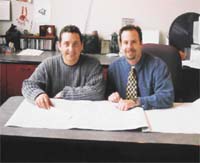Reprinted with permission from Modern Woodworking Magazine.
By Kevin Strickland
Expansion. It’s the dream of most small businesses. The need for expansion usually indicates that a business is successful and growing. Without careful planning, however, expansion can become a costly nightmare. Here’s how to avoid some of the pitfalls.

CVI co-owners Scott DeGenova and Timothy Wanat are now reaping the benefits of expansion.
To insure a smooth expansion, a company needs to have a carefully researched plan in place, says Scott DeGenova, president of CVI. That plan should provide for the purchase and installation of any new machinery, the minimization of downtime, research of the building before signing the lease and the existence of a lease agreement that allows the company to remain in place during any unforeseen delays in moving. Unfortunately for DeGenova, some of these lessons were learned the hard way.
1. Invest in and Install New Equipment Before the Move
To prepare for the increase in volume with its new facility, the company purchased a Holzma Model HPP81 beam saw at a cost of $150,000. The new machine was added to a complement of machinery that already included a Morbidelli author 504STC point-to-point drilling machine, a Holz-Her 1436 edgebander, a Holz-Her 1265 vertical panel saw, a Griggio 10’ sliding table saw and a Ritter case clamp. In addition to tripling the physical capacity, production was increased by more than 50 percent.
According to DeGenova the anticipated and actual costs of the initial expansion were nearly identical. “Everything looked rosy when we made the move. We were excited about the potential and excited about the future,” DeGenova said.
Nearly $250,000 had been budgeted for the expansion. Approximately $30,000 was earmarked for computers, software and phone systems. Another $70,000 was delegated to office buildout — an expense which included office furniture and fixtures.
2. Minimize Downtime with Revamped Production Schedule
3. Research before Signing Lease
Once the move was completed, however, new problems mounted for CVI. “When we moved into the facility we faced extended external problems,” DeGenova continued. “There were numerous building code violations that had to be rectified. There was the issue of non-payment of taxes. Several times the building was closed down until these problems could be resolved. At one point we were locked out of the building for an entire week. In addition, utilities for the building, which were the responsibility of the landlord, were not paid which resulted in their being shut off for over a year. We had to purchase and run a large diesel generator just to maintain utilities to the operation.”
DeGenova said that a few pre-move precautions could help others avoid facing a similar set of circumstances. “Before considering a move, I would recommend talking with other tenants if it is a multi-tenant unit,” DeGenova stressed. “They can tell you what problems they might have had and what had to be done to rectify those problems. If the building is unoccupied, check with the building department. In addition, it would be wise to question building inspectors and the fire chief. They should be aware of any possible code violations that could cause problems.”
DeGenova also suggested contacting the county tax assessor’s office to research the building’s tax bill. The tax history and any liens against the building would be recorded there.
4. Maintain an Open Line of Communication with your Current Landlord
Taking measures to minimize downtime still did not guarantee a smooth transition. Renovation of the new facility took longer than originally anticipated, and the company was forced to move into the new location before it was completely ready.
Maintaining an open line of communication with your current landlord could help prevent such an eventuality.
“Ideally, everything should be complete before moving into a new location,” DeGenova said. “If you run into delays in renovating a new location, it is important to have a back up plan with your current landlord. A provision that would extend your current lease if you were not ready to move when it expires would be beneficial.”
Reprinted with permission from Modern Woodworking Magazine. Free subscriptions are available by completing an on-line Subscription Form.